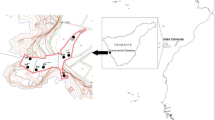Abstract
Submarine caves are semi-closed subsystems within the marine littoral ecosystem. One of the most striking features is the progressive reduction of the number of phyla, species, and biomass towards the interior of such a cave. The decrease in biomass has been explained as the result of low exchange rates of the water inside the caves which limit the supply of oxygen and food particles from the exterior. Many authors have proposed that this reduced exchange rate is associated with the occurrence of marked gradients in temperature, salinity, oxygen and light. Measurement of faunal abundance of a cave in the littoral zone of the Medes Islands (Catalonia, north-east Spain) made between June 1983 and July 1984, revealed a zonation similar to that in other Mediterranean caves. Animal biomass decreased from 260 g ash-free dry weight m-2 at the entrance to 80 g ash-free dry weight m-2 at the end of the cave (50 m from the mouth). A special technique for remote water-sampling was developed to avoid problems due to turbulence caused by divers in this semi-closed system. This involved the installation of a series of plastic tubes at different points along the axis of the cave. The water was brought to the surface using a battery-powered electric pump. The reliability of this method was verified by comparing the results with samples collected directly by divers. Sampling both in winter and summer showed no longitudinal gradients for temperature, salinity, oxygen, chlorophylla and the number and volume of suspended particles. These results suggest that there is a constant circulation within the cave which guarantees water-exchange. The decrease in biomass cannot be explained by physico-chemical gradients due to insufficient exchange with the external system. On a finer scale, however, along the walls of the cave there may exist boundary layers that are not affected by the general circulation. This could account for the observed decrease in the biomass of benthic organisms.
Similar content being viewed by others
Literature cited
American Public Health Association: Standard methods for the examination of water and wastewater, 15th ed. 1134 pp. Washington: A.P.H.A. 1983
Bibiloni, M. A., J. M. Gili et J. Ros: Les coves submarines a les illes Medes. Arx. Secc. Ciènc. Inst. Estud. catalans73, 707–738 (1984)
Cinelli, F., E. Fresi, L. Mazzella, M. Pansini, R. Pronzato and A. Svoboda: Distribution of benthic phyto- and zoocenoses along a light gradient in a superficial marine cave.In: Biology of benthic organisms, pp 173–184. Ed. by B. F. Keegan, O. Leidingh and P. J. S. Boaden. London: Pergamon Press 1978
Crisp, D. J.: Energy flow measurements.In: Methods for the study of marine benthos. pp 284–372. Ed. by N. A. Holme and A. D. McIntyre. Oxford: Blackwell Scientific Publications 1984. (IBP Handbook No 16)
Eppley, R. W., N. G. Harrison, S. W. Chisholm and E. Stewart: Particulate organic matter in surface waters off Southern California and its relationship to phytoplankton. J. mar. Res.35, 671–696 (1977)
Flos, J.: Variability of Coulter Counter data and their relationship with other oceanographical parameters. Pubbl. Staz. zool. Napoli (I: Mar. Ecol.)5, 197–216 (1984)
Gili, J. M., I. Olivella, M. Zabala y J. Ros: Primera contribución al conocimiento del poblamiento bentónico de las cuevas submarinas del litoral catalán. Acta ler Simp. ibér. Estudios Bentos mar.2, 813–836 (1982)
Harmelin, J. G.: Bryozoaires des grottes sous-marines obscures de la région marseillaise, faunistique et écologie. Téthys1, 793–806 (1969)
Jørgensen, C. B.: Biology of suspension feeding, 357 pp. London: Pergamon Press 1966
Laborel, J.: Contributión à l'étude des peuplements benthiques sciaphiles sur substrat rocheux en Méditerranée. Recl Trav. Stn mar. Endoume33, 117–173 (1960)
Laborel, J. et J. Vacelet: Etude des peuplements d'une grotte sous-marine du golfe de Marseille. Bull. inst. océanogr., Monaco55 (1120), 1–20 (1958)
Margalef, R.: Ecologia, 951 pp. Barcelona: Omega 1974
Pérès, J. M. et J. Picard: Nouveau manuel de bionomie benthique de la Mer Méditerranée. Recl Trav. Stn mar. Endoume47, 1–137 (1964)
Pouliquen, L.: Les Espongiaires des grottes sous-marines de la région de Marseille, écologie et systematique. Téthys3, 717–758 (1972)
Reiswig, H. M.: Particle feeding in natural population of three marine demosponges. Biol. Bull. mar. biol. Lab., Woods Hole141, 568–591 (1971)
Riedl, R.: Biologie der Meereshöhlen, 636 pp. Hamburg: Paul Parey 1966
Starmühlner, F.: Investigations about the molluscfauna in submarine caves. Proc. Symp. Mollusca1, 136–163 (1968). (Ernakulam, Cochin: Marine Biological Association of India)
True, M. A.: Etude quantitative de quatre peuplements sciaphiles sur substrat rocheux dans la région marseillaise. Bull. Inst. océanogr., Monaco69 (1401), 1–48 (1970)
Zabala, M., J. M. Gili, T. Riera y M. F. Huelin: Estudio de los factores fisicos y biológicos de una cueva submarina del litoral catalán. I: Metodología y primeros resultados. Acta 4er Simp. ibér. Estudios Bentos mar.1, 109–121 (1984)
Zibrowius, H.: Les Scleractiniaires des grottes sous-marines en Méditerranée et dans l'Atlantique nord orientale (Portugal, Madère, Canaries, Açores). Pubbl. Staz. zool. Napoli40, 516–545 (1978)
Author information
Authors and Affiliations
Additional information
Communicated by J. M. Pérès, Marseille
Rights and permissions
About this article
Cite this article
Gili, J.M., Riera, T. & Zabala, M. Physical and biological gradients in a submarine cave on the Western Mediterranean coast (north-east Spain). Mar. Biol. 90, 291–297 (1986). https://doi.org/10.1007/BF00569141
Accepted:
Issue Date:
DOI: https://doi.org/10.1007/BF00569141




